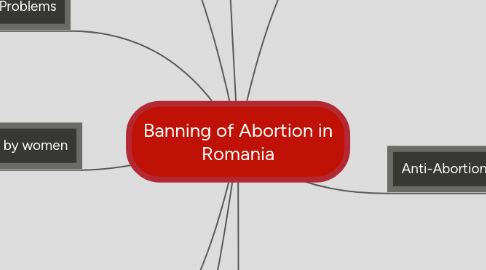
1. State Incentives for women not to abord
1.1. childcare facilities made available
1.2. guaranteed maternity leave
1.3. job security
1.4. Medals of honor
1.5. access to medical attention
1.6. financial allowances
1.7. child support benefits
2. Methods taken by women
2.1. Contraceptives on black market
2.2. illegal and dangerous abortions
2.3. abstinence
2.3.1. disruption for both married couple relationships as well as singles
2.4. Coitus interruptions
2.4.1. Another for of disruption in relationships
3. Other Problems
3.1. 1983-84
3.1.1. Ceausescu decides to repay all foreign debt
3.1.1.1. Production targeted for export
3.1.1.2. Citizens suffered food rations
3.1.1.3. little heat or electricity available
4. Orphanages filled
4.1. How?
4.1.1. Mothers could not feed or care for more children so they abandoned them
4.1.2. Since abortion was illegal, some mothers abandoned their child at the hospital or gov institutions thinking they should have them since they wanted them
4.1.3. Mothers were imprisoned if thought to have had or participated in abortions sometimes leaving many children motherless
4.2. rise of Infant AIDS
4.3. International trafficking of babies and children
5. Why?
5.1. Under communist Ceausescu's rule
5.2. Birthrate was down
5.3. Ruler wanted to build a socialist state
6. Extra Note:
6.1. I remember watching an episode of "freak-enomics" where they were discussing why the crime rate in NY had drastically decreased over a specific span of time. They demonstrated how it was most logically because of the law legalizing abortion in that state some decade ago by comparing Romania's huge increase in crime a decade after Ceausescu's rule. It makes sense because you had so many unwanted and abandoned children who had now grown up and became criminals do to such a traumatic upbringing, whereas unwanted pregnancies in NY were aborted.
7. Roles of Romanian women
7.1. Work force
7.1.1. Agriculture
7.1.1.1. Flexible hours
7.1.2. Cutural insitutions
7.1.3. educational institutions
7.1.4. light industry work
7.2. Family/Work
7.2.1. Obligatory child producers
7.2.1.1. State mandated to have multiple children
7.2.1.2. Help form healthy and robust generations
8. Anti-Abortion laws
8.1. Law 770/1966
8.1.1. Prohibited abortions
8.1.2. Exceptions
8.1.2.1. if the pregnancy endangered the life of the women and no other means could be taken
8.1.2.2. hereditary disease involved
8.1.2.3. preganacy result of a rape
8.1.2.4. woman was 45 or older
8.1.2.5. If she had already delivered & reared 4 children
8.2. end of 1970's
8.2.1. Gypsy women were permitted to get abortions
8.2.1.1. Form of ethnic population control
8.3. Dec. 26, 1985
8.3.1. stringent abortion law
8.3.1.1. All same laws under 770 rule still applied
8.3.1.2. expected number of children raised to 5
8.3.1.3. Any persons childless over 25 would be taxed
8.4. 1986 Health Campain
8.4.1. unique to history of Romanian medicine
8.4.2. Analyzing the health of the population
8.4.2.1. esp. women of childbearing years
8.4.3. A way to stop illegal abortions
8.4.3.1. If woman found pregnant then doctors could "monitor" her
8.4.3.2. Women who had previous abortions could be detained in a hospital
8.4.3.3. Physicians held accountable
9. Post Ceausescu
9.1. December 1989
9.2. Executed
9.3. Abortion became legal
9.3.1. Became most popular form of birth control
9.4. Sex and family education needed for citizens
9.4.1. will help prevent the need for abortions
9.4.2. help promote safer ways of birth control
9.5. Romania became adoption hot spot
9.5.1. creation of a an organized system for adoption needed
9.5.1.1. Failed due to lack of staff and technology
9.5.2. Families began to see children as commodities
